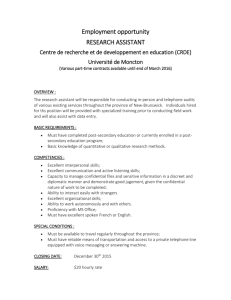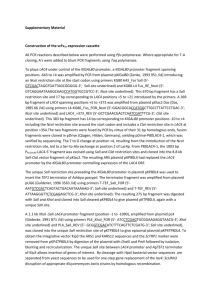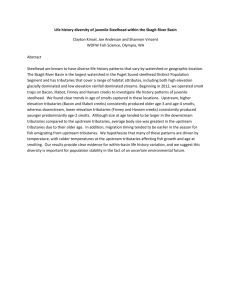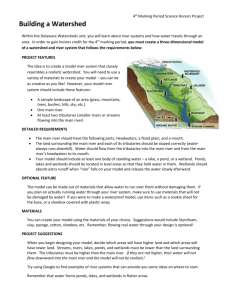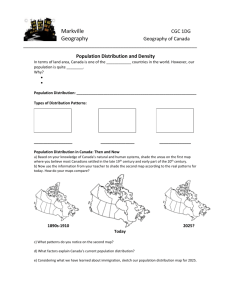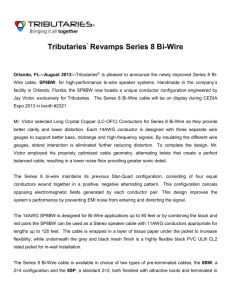annex e-3: water quality problems in the province of
advertisement
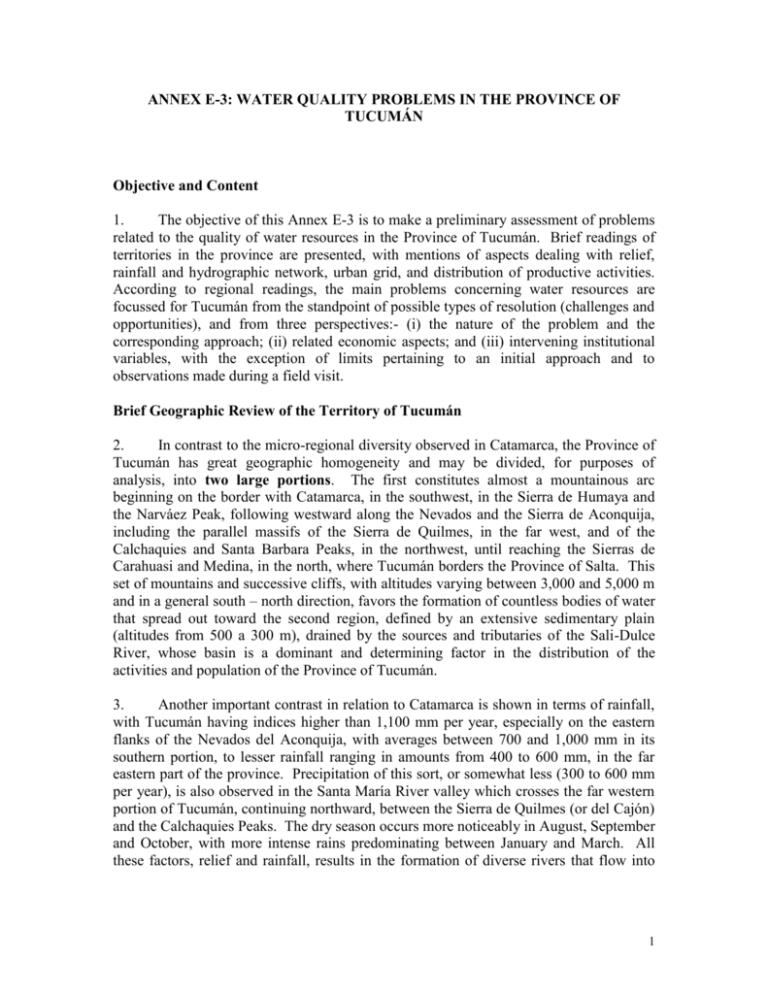
ANNEX E-3: WATER QUALITY PROBLEMS IN THE PROVINCE OF TUCUMÁN Objective and Content 1. The objective of this Annex E-3 is to make a preliminary assessment of problems related to the quality of water resources in the Province of Tucumán. Brief readings of territories in the province are presented, with mentions of aspects dealing with relief, rainfall and hydrographic network, urban grid, and distribution of productive activities. According to regional readings, the main problems concerning water resources are focussed for Tucumán from the standpoint of possible types of resolution (challenges and opportunities), and from three perspectives:- (i) the nature of the problem and the corresponding approach; (ii) related economic aspects; and (iii) intervening institutional variables, with the exception of limits pertaining to an initial approach and to observations made during a field visit. Brief Geographic Review of the Territory of Tucumán 2. In contrast to the micro-regional diversity observed in Catamarca, the Province of Tucumán has great geographic homogeneity and may be divided, for purposes of analysis, into two large portions. The first constitutes almost a mountainous arc beginning on the border with Catamarca, in the southwest, in the Sierra de Humaya and the Narváez Peak, following westward along the Nevados and the Sierra de Aconquija, including the parallel massifs of the Sierra de Quilmes, in the far west, and of the Calchaquies and Santa Barbara Peaks, in the northwest, until reaching the Sierras de Carahuasi and Medina, in the north, where Tucumán borders the Province of Salta. This set of mountains and successive cliffs, with altitudes varying between 3,000 and 5,000 m and in a general south – north direction, favors the formation of countless bodies of water that spread out toward the second region, defined by an extensive sedimentary plain (altitudes from 500 a 300 m), drained by the sources and tributaries of the Sali-Dulce River, whose basin is a dominant and determining factor in the distribution of the activities and population of the Province of Tucumán. 3. Another important contrast in relation to Catamarca is shown in terms of rainfall, with Tucumán having indices higher than 1,100 mm per year, especially on the eastern flanks of the Nevados del Aconquija, with averages between 700 and 1,000 mm in its southern portion, to lesser rainfall ranging in amounts from 400 to 600 mm, in the far eastern part of the province. Precipitation of this sort, or somewhat less (300 to 600 mm per year), is also observed in the Santa María River valley which crosses the far western portion of Tucumán, continuing northward, between the Sierra de Quilmes (or del Cajón) and the Calchaquies Peaks. The dry season occurs more noticeably in August, September and October, with more intense rains predominating between January and March. All these factors, relief and rainfall, results in the formation of diverse rivers that flow into 1 the Sali-Dulce River along the right bank. Mention needs be made of only two tributaries of lesser importance on its left bank. 4. Land occupation in the Province is somewhat conditioned by the natural factors mentioned above, and activities and population are scarce in the mountainous region. In contrast, the principal urban centers are located along the course of the Sali River, strongly polarized by the central location of the capital, San Miguel del Tucumán. With an area of only 22,524 km2, the Province of Tucumán, with the exception of Greater Buenos Aires, has the greatest population density compared to all other Argentine provinces (50.7 inhab/km2), with a total of 1,142,105 inhabitants, of whom 622,324, or 54%, reside in Greater San Miguel del Tucumán1. The cities of Tafi Viejo, Yerba Buena, Banda del Sali (on the left bank of the Sali River) and even Lules, only 10 km away from urbanized areas of Greater Tucumán, may be included as being directly integrated with the capital. 5. The other urban centers lie along highways (Route 38, principally). We should mention the following cities toward the south, below the capital: Bella Vista (with nearly 25,000 inhab.), Famailla (25,000 inhab.), Monteros (30,000 inhab.), Concepción (the province’s second largest city, with nearly 60,000 inhab.) and Alquilares (25,000 inhab.). However, it may also be mentioned that the location of the service sector and of other complementary industries reinforces the central position and polarization exerted by Greater San Miguel del Tucumán. 6. Favorable soil conditions, rainfall and the generous hydrographic network – characterizing the Province of Tucumán almost as an oasis carved into western Argentina -, has allowed the development of significant crops, without the need to use intensive irrigation, administered during the dry months of August to October. Even now, sugar cane still predominates, accompanied by around 15 (fifteen) important processing plants and alcohol distilleries, in scattered locations but not too far from the capital. Recent problems of competition, especially in light of Brazilian production2, have brought this agroindustrial sector certain difficulties, with the substitution of areas planted with citrus (lemons), also accompanied by their respective processing industry. It should also be noted that all these crops occupy available plains between the tributaries of the Sali River, which run parallel from mountain slopes, on the border with Catamarca, in a westeast direction. 7. It is timely to note that practically the entire territory of Tucumán is delimited by the basin contributing to the Sali River, as it is called in the upper portion of the SaliDulce until it reaches the point where the Gastona, Chico (or Medina) and Marapá (or Granero) Rivers meet. In this region, after turning from south to southeast, the Sali’s contributing basin narrows considerably (at this point, only 1,000 to 1,500 m wide), used 1 2 1991 Census Data. Brazilian agroindustry associated with sugar cane has specific incentives offered by the National Alcohol Program, utilized with automotive fuel, directly or mixed in variable percentages with the gasoline consumed in Brazil. 2 to “fit” and construct the important Frontal dam on the Hondo River (storage of 1,050 Hm3), after which the Sali is called the Dulce, in the territory of Santiago del Estero. 8. With this peculiar geographic formation, the Frontal de Río Hondo reservoir – into which the above-mentioned Gastona, Chico (or Medina) and Marapá (or Granero) Rivers, as well as the Sali itself, flow -, becomes the final depository for all loads from the province, brought by surface dragging or by direct dumping, into the tributaries or main body of the Sali River. Consequently, the characterization of problems related to the water quality of this reservoir, allows a rather precise reading of its origins and principal sources of contamination. Characteristics and Availability of Water in the Sali-Dulce River Basin 9. The Sali-Dulce River begins with the name Tala, at altitudes of 5,000 m observed in the Sierra de Carahuasi, on the northern border between Salta and Tucumán. It then becomes known as the Sali at the point where it meets the Candelaria River, 55 km from its origin. From this point, it moves south, crossing the entire southern portion of Tucumán, on a 225 km course, during which it receives, along the right bank, countless contributions that originate on the eastern slopes of the mountains and cliffs that mark its borders with Catamarca, until turning southeast, toward the border with Santiago del Estero, where the Frontal de Río Hondo reservoir is located. 10. The upper course of the Sali, from its sources to La Aguadita dike, has slopes of around 4.5°/oo, with a predominant substratum of round pebbles, an even more notable feature in its tributaries. In its middle stretch, near Greater Tucumán, the Sali River has lesser slopes, around 2.5°/oo, decreasing to 1.0°/oo in its lower stretch near the Frontal de Río Hondo reservoir. Along these stretches with lesser slopes, the round pebbles disappear, gradually replaced by average, and then fine, grained sand. This same typology is observed in its principal tributaries, presented according to their principal characteristics in Table 1, below. Table 1 – Characteristics of the Principal Tributaries of the Sali-Dulce River Direct Tributaries Area of Contributing Sub-basin (km2) Observed Flow Rates (m3/s) Average Maximum Dry Season (7) Tala (1) Candelaria (1) Acequiones Choromoro Vipos Rio Loro (2) Tapias Calera (2) Sali (3) Lules 930 580 650 650 840 80 225 460 (partial) 800 3.13 0.58 4.27 1.55 3.98 0.16 0.58 1.46 16.93 5.48 10.1 217.0 22.40 1.01 0.56 0.77 2.00 1.44 3 Balderrama (4) Seco Gastona Chico (or Medina) Marapá (or Granero) 2,770 560 1,060 2,080 1,830 11.79 1.52 12.38 9.15 3.91 36.00 63.10 10.65 (5) 2.48 1.30 1.32 4.70 Sources: Comparison of historical series of the Department of Irrigation of the Province of Tucumán and Information on Sanitation Works in Tucumán (mimeo - 1999) (1) – Rivers forming the Sali River; (2) – Tributaries on the left bank of the Sali River; (3) – Estimated flow rates at La Aguadita Dike; (4) – The sub-basin of the Balderrama River includes the following tributaries: Aranilla, Colorado, Pueblo Viejo and Romano; (5) – Flow regulated by the Escaba Dam; (6) - ( - ) Data unavailable or omitted due to inconsistencies among different sources; (7) – Minimum historical rates of flow observed, or dry season averages 11. According to the different sources consulted and to data from the above table, the basin actively contributing to the Sali River, within Tucumán, is between 10,500 and 12,700 km2. In light of the above-mentioned features of its formation, many of its 40 (forty) secondary tributaries, or of its 118 (one hundred eighteen) tertiary tributaries have more important flow rates and regional significance than some of the direct tributaries listed. Comparing data on area of contribution, rainfall and available flow, one may note that, in its middle and upper portions, the Sali and its tributaries have a runoff factor of between 3.8 l/s and 4.3 l/s per km2 of river basin. When the entire Sali-Dulce basin is observed, i.e., including the entire lower portion, in which the Sali becomes known as the Dulce River, in the territories of Santiago del Estero and then Córdoba -, average water availability exceeds 90 m3/s, of which over 65% is contributed only by the Balderrama, Seco, Gastona and Chico (or Medina) tributaries. Adding to these generous available flow rates are the seasonal contributions of snow and ice coming mainly from the Nevados de Aconquija. However, no systematic measurements were found that would allow the establishment of factors to correlate the volumes that become available. 12. Two additional mentions are important with regard to water availability in the Sali River basin. The first deals with the economically usable potential for power generation, estimated at around 250,000 KW, possibly reaching 340,000 KW, with regulated flows. These include, on the Sali River itself, El Cadillal (used for power and supply) and Frontal de Río Hondo reservoirs (used for power and irrigation), as well as Potrero de las Tablas, Angostura River, Potrero del Clavillo (with a significant potential of 120,000 KW) and the Escaba Dam, on the Marapá or Granero River. 13. The second refers to groundwater reserves, located in aquifers formed by filtration along the left bank of the Sali River, in the eastern region of the province, in which good water quality is obtained, especially in the third layer of the water table. As seen in greater detail below, Greater San Miguel del Tucumán utilizes these aquifers, supplying drinking water from over 140 wells, with a total extracted flow of around 1.5 m3/s, with the largest individual contribution being 250 m3/hour. 4 Water Resources Problems in the Province of Tucumán Problem 1: Natural Quality of Available Waters 14. It may be stated that water in the Province of Tucumán is generally of good quality, especially in tributaries originating on the eastern slopes of the borders with Catamarca and, according to the previous paragraph, in the underground springs in the eastern part of the province. With regard to the Sali River, two problems related to the natural quality of its waters should be noted. The first refers to the slightly saline level observed in its middle portion, where values of around 2 gr/liter (sodium chloride and sulfate) have been noted, during more critical dry periods. 15. The second is more alarming: it refers to high percentages of manganese, present in significant quantities in El Cadillal reservoir, located around 15 km north of the provincial capital, whose storage capacity (300 Hm3) is used to generate electricity and as the principal source of drinking water supply for Greater Tucumán. According to information from the concessionaire, the concentration of manganese (and of iron, in smaller quantities) accumulated at the bottom of the reservoir may reach 600 mg/m3, often making the necessary potabilization difficult. On these occasions, operating agreements signed with the power operator enable pumping to be done automatically by equipment on the lake surface, in order to mitigate the problem. This concentration is caused by natural silting, particularly during critical floods, resulting in an accumulation in El Cadillal reservoir. Since there are no upstream, man-made sources of nutrient generation, the eutrophication observed in the reservoir is also caused naturally by silting, facilitated by the more elevated slopes of the Sierras de Curahuasi and Medina, where the sources of the Sali River are found. Problem 2: Silting and Contamination from Surface Runoff of the Sali River, its principal tributaries and the Frontal del Río Hondo Reservoir a) Definition of Problem – Main Indicators: 16. Silting is clearly a relevant problem in the Province of Tucumán. The intense rains and elevated slopes at sources, followed by sandy riverbeds that develop in lowsloping plains in the middle and lower portions of the Sali and its principal tributaries, not only favor the occurrence of seasonal floods but especially a significant level of silting. The result of this process may be seen at the Frontal reservoir for which silt build-up was estimated at around 28% in the mid-1970s, with an average of 0.8% per year. From information gathered at interviews with the State Secretariat of Environment of the Province of Tucumán, it is estimated that loads contributed to the Frontal reservoir would have the following composition: 83% from rural runoff, 11% from industrial waste, 4% from solid urban waste and 2% from household sewage. The graph below shows a typical section of the Sali’s tributaries, seen in its middle sections, during the dry season. 5 Typical Section of Tributaries to the Sali River crop zone sandy river bed, moveable in dry season 15 m (on average) crop zone 1.50 m 80 to100 m 17. Systematic measurements made in the 1950s, in the Sali’s secondary and primary tributaries, allowed the establishment of an average surface runoff of 2.70 kg/m3, which results in a solid volume at the Frontal reservoir of 170 kg/s, i.e., 255 tons per year and per km2 of river basin3. In light of intensive soil use in the crops mentioned (sugar cane, etc.), in which agrochemicals and fertilizers are applied in considerable quantities, it is expected that this runoff of solids will be accompanied by significant quantities of compounds and nutrients. In fact, recent studies (August/98 to March/99) found the presence of organochlorate pesticides (PO), especially lindane (concentrations of up to 2 g/l) and methoxichlorine (up to 1.3 g/l), increasing with greater volumes in the Sali4. It is worth noting that common features of these compounds are “low solubility in the water and high solubility in most organic dissolvents, which makes it possible to anticipate that […] they will tend to accumulate in the fatty tissues of living organisms,” as well as being “included among the most persistent compounds in the environment”5. 18. In addition to the above-described effects of contamination, the runoff of solids and the consequent silting in bodies of water favors the occurrence of floods, which are especially notable during the months of November, December and January, and which take place with greater intensity in the Sali’s more abundant tributaries:- Medina, Gastona, Romano and Mandolo. In addition, localized flooding problems affect lowerlying areas adjacent to the capital, in the Lules River zone of influence, affecting inhabitants along riverbanks and vegetable and fruit crops. 19. Finally, in addition to water quality problems in the Sali River basin, we should mention industrial waste. The Secretariat of Environment of the Province of Tucumán has listed as sources of relevant effluents: 16 sugar refineries, 03 autonomous distilleries, 08 citrus processing plants, 06 meat packing plants, as well as 07 other diverse industries, 3 4 5 Similar estimates, with a total of 3,325,000 tn/year (255 x 12,700 km2), are contained in the document by TETRA TECH Argentina S.A. – Propuesta Técnica para Elaborar el Estudio Integral de la Conducción and Tratamiento Conjunto de Desagues Industriales y Cloacales de la Cuenca del Embalse Termas de Río Hondo(Technical Proposal for the Preparation of the Comprehensive Study of Joint Conduction and Treatment of Industrial and Sewage Waste from the Termas de Río Hondo Reservoir) – mimeo (1999). Chaile, Adriana P. et alli – Plaguicidas Clorados en El Sali River (Chlorinated Pesticides in the Sali River)– Tucumán/Argentina - mimeo; Department of Chemistry, Faculty of Natural Sciences, National University of Tucumán (1999). Idem. 6 including a paper mill, all in a single row, according to their location in the sub-basins contributing to the Sali, in the section between El Cadillal and the Frontal del Río Hondo reservoirs. In order, let us consider the following priority:- solids and pesticides, sediment from wine and distilled alcohol production; effluents from citrus processing (whose volume is high and whose biological treatment is acknowledged to be difficult, including waste from the production of oil made from lemon rinds; and waste from the paper mill (540 l/s), dumped after only primary removal. 20. With regard to the sugar-alcohol industry, note Table 2, which lists the principal sugar refineries and alcohol distilleries, with their respective production and effluent dumping capacities6. The comparison of these values (Table 2) with historical data collected in the 1950s makes it possible to note a certain stagnation (with indications of some decline) in sugar-alcohol production in the Province; this fact is mentioned as a justification for difficulties in modernizing productive processes, rationalizing consumption and reducing dumping by this industrial sector. It is estimated that current water consumption by these factories could be reduced by 70%, as well as the possibilities of resolving the final disposal of sediment, which is highly relevant due to its high DBO potential – Biochemical Demand for Oxygen, as well as nutrients. 21. Added to this waste is that stemming from the processing of 550,000 tn/year of citrus, as well as the previously mentioned 540 l/s of effluents from Tucumán’s paper mill, dumped with only primary removal. Localized problems also occur due to waste from meat packing plants and, to a lesser degree, from beverage Table 2 – Principal Sugar Refineries and Alcohol Distilleries Name of Refinery and/or Distillery Sugar production (tn/year) 1. La Flórida (Balcanes) 60,000 2. Concepción 250,000 3. San Juan 60,000 4. Cruz Alta 40,000 5. Bella Vista 60,000 6. Leales 30,000 7. Fronterita 90,000 8. Nuñorco 80,000 9. Santa Rosa 60,000 10. La Providencia 90,000 11. La Corona (Lapataia) 60,000 12. La Trinidad -Trial 90,000 13. Aguilares - Nasa 40,000 14. Santa Bárbara 90,000 15. Marapá 50,000 16. Química Leales 1,150,000 Total Source: TETRA TECH Argentina S.A. 6 Effluent volume (m3) 4,800,000 20,000,000 4,800,000 3,200,000 4,800,000 2,400,000 7,200,000 6,400,000 4,800,000 7,200,000 4,800,000 7,200,000 3,200,000 7,200,000 4,000,000 92,000,000 Alcohol production (m3/ano) 72,000 300,000 72,000 72,000 36,000 108,000 72,000 72,000 108,000 48,000 108,000 60,000 36,000 1,164,000 Volume of waste produced (m3) 720,000 3,000,000 720,000 720,000 360,000 1,080,000 720,000 720,000 1,080,000 480,000 1,080,000 600,000 360,000 11,640,000 . TETRA TECH Argentina S.A., doc. cited. 7 Obs: (1) Sugar refineries operate between May and November (7 months), with total effluents equivalent to a flow rate of 5.07 m3/s; (2) Alcohol distilleries operate between March and December (10 months), with sediment dumping equivalent to a flow rate of 0.45 m3/s; b) Resolution of Problem (Challenges and Opportunities): 22. Despite its lesser importance from a biological standpoint, there is no question that sediment erosion constitutes, by far, the main problem in this river basin, especially due to the drastic and continuous reduction in the reserve volume of the Frontal Dike, as well as the drainage and runoff capacity of the principal tributaries and that of the Sali River itself. There are no immediate, definitive structural solutions to this problem, although the potential of several civil works (dams to regulate flow rates) should not be overlooked, whose location and, moreover, operation and maintenance may contribute to reduce the amount of sediments. However, the actions that could offer a better result will be those related to soil management in micro-catchments and especially the recovery of vegetation, totally nonexistent along riverbanks as noted during a field visit. 23. With regard to industrial waste, although in lesser volumes, it is necessary to stress that it has a high potential for contamination, and very likely constitutes the principal cause of the eutrophization seen in the Frontal reservoir. Since the problem is relatively well known (and estimated), it is hoped that public authorities will work for the application of legal provisions on effluent disposal, whenever possible having them go hand-in-hand with the implementation of incentives for the modernization of productive processes, in order to reduce extraction demands and consequently the related dumping. However, interviews made it possible to identify that the environmental enforcement exercise also needs to overcome another type of obstacle. Along with the usual lack of means that recurs in environmental secretariats, authorities expressed great concern regarding the difficulties and the viability of the region’s sugar-alcohol sector, doubly recognized as the Province’s principal economic (and historically dominant) activity and the major source of water pollution, both in light of waste from refineries and distilleries and of soil management in planted areas associated with them. 24. Thus, in a national context of economic difficulties and depression, it seems difficult to ensure priority for investments aimed at improving the environmental performance of this productive sector, especially when negative externalities are making themselves felt downstream, far from the activities that generate them. In this regard, the recent (three years ago) reactivation of the Sali-Dulce River Basin Committee – in the context of which the possibility of charging for the use of water resources is being negotiated, with amounts around US$25.00/ha -, may constitute an external factor that could impose positive measures within the Province of Tucumán. Problem 3: Environmental Problems in Greater San Miguel del Tucumán a) Definition of Problem – Principle Intervening Variables: 8 25. The urban environmental problems of Greater San Miguel del Tucumán remain to be dealt with, since this is the province’s largest city, with a current population of over 650,000 inhabitants. The issues requiring certain attention are well-known: (i) guaranteed supply of drinking water; (ii) sewage collection and treatment services; (iii) collection and proper final disposal of urban solid waste; and (iv) the growth of irregular land occupation, promoted by low-income families, particularly in inadequate areas, along rivers and streams that flow through urbanized areas. 26. Greater Tucumán is supplied mainly by extractions from El Cadillal Dike, which is responsible for a flow rate of potable water of 1.61 m3/s, sent exclusively to San Miguel. Another 0.70 m3/s are conducted 40 km away, at the Vipos River, plus another 1.24 m3/s from the Muñecas Plant and water from 140 wells (average depth of 150 m and pumping possible, starting at 70 m), making a total of around 3.55 m3/s. This flow rate allows minimum indices of supply to close to 90% of Greater Tucumán’s population. A comparison of water conducted and population serviced shows a high per capita consumption of 550 to 590 l/inhab./day, similar to the situation observed in Catamarca. 27. In fact, it should be acknowledged that the recent cases of vulnerability in the commercial system and incipient tariffs imply the absence of mechanisms to promote the administration of demands for water consumption. Information collected during interviews assure that, in neighborhoods with greater purchasing power, and with larger lands and constructed areas, unit costs reach 900 l/inhab./day. In Greater Tucumán, just over 3,000 (or 2.5%) of 122,103 accounts are micro-metered, while the consumption of others is presumed in terms of the constructed area. In the province’s other departments, the concessionaire’s service index is just over 63%, serving 330,000 inhabitants and 74,252 accounts, in 1998, the results of the recent effort to register and expand service 7. Current average tariffs are around US$25.00 per connection/every two months. 28. With regard to household sewage, sewer service is concentrated in San Miguel de Tucumán, with an index of around 75% of homes served, dropping to 55% in Tafi Viejo and just over 10% in Yerba Buena8. Of all sewage collected, only 20% is treated; thus, just over 12% of Greater Tucumán, with the largest plant equipped only for primary treatment. The resulting effluents are dumped into the Sali River. 29. During the field visit, deficiencies were observed in collection services for solid waste which accumulates (plastics, glass, papers, cans and metal) along the streams and creeks that flow through the capital. These focuses of local contamination may become a relevant and growing problem as low-income populations, migrating toward larger urban areas, begin building ramshackle houses, especially along drainage canals in areas subject to frequent flooding. In these locations, the supply of sanitation services (water, sewer, 7 8 In 1995, only 65,997 accounts were registered in the interior, according to data by Obras Sanitarias Tucumán (OST). Source: TETRA TECH Argentina S.A., Proposal cited. The indices provided by the concessionaire for sewage collection and treatment services are even lower. 9 trash collection and drainage), in general, is hindered by variables of geography and accessibility. 30. Finally, another issue that merits attention is the final disposal of collected solid waste, done by a private concessionaire in a controlled sanitary landfill; its substratum, according to local data, is waterproofed in the water table and clay layer. However, at first sight, the location of this landfill appears too close to the Sali River, less than 1 km from its banks, in a zone with potential infiltration of surface waters that flow along the right bank of the Sali, toward the aquifers that form under lands on its left bank. Thus, it is worth noting that the combination of geological formation and the slope of inner soil layers favors the infiltration of percolates that are formed by decomposed solid waste (chorume), in the direction of aquifers. b) Resolution of Problem (Challenges and Opportunities): 31. Problems pertaining to water supply and sewage collection appeared to have a quick and definitive solution when services were privatized and placed under the responsibility of a French-Spanish consortium, led by General des Eaux. However, this concession is now under intervention, and the contract has been suspended and submitted for legal claims. The episode is mentioned frequently by segments resistant to the privatization of basic sanitation services, along with others (including Brazil), as a good example of failure. 32. Without disregard to the investigation of reasons for the failure of the privatization experience in Tucumán, several statements deserve mention and aid in elucidating the facts. First, it should be acknowledged that indicators of service, and especially of the company’s commercial and financial efficiency, were extremely shaky, which implies an admission that, although services were supported by significant subsidies, a situation of insufficiency remained and worsened, in terms of population served and of the maintenance of available assets. Testimonies about the advanced deterioration of installed infrastructure, more specifically with regard to waste collection and treatment – socially less visible services – may be obtained from the technical staff that continues working during the current period of intervention. 33. Investments for the recovery and maintenance of assets, and especially for treatment and disposal of effluents, are not readily perceived by consumers, except by the incremental population contemplated by the expansion of drinking water supply. On the other hand, the wearing-out of essential readjustments for the recovery of tariff levels occurs widely and immediately, even though, in the case in question, the imperative of such readjustments has been recognized and approved by the provincial legislature, but not implemented. This being said, the importance of debates on the opportunity of private concessions is highlighted, in circumstances where there is a great distance between the actual and future sustainability of services – either prior investments are used, or a transition phase is begun which diminishes the expected public reactions stemming from the impacts of tariffs on household accounts. Both of these alternatives 10 were absent in the case of Tucumán, both from the viewpoint of the grantor or in the strategies adopted by the concessionaire. 34. Despite its high level of proficiency in the matter, the provisional nature of the current situation is acknowledged by the Board of Directors in charge of managing the intervention period. A challenge to the regular order of business in Tucumán, is the organization of regulatory instruments suitable for administering a second – and inevitable –procedure for awarding services to third-parties, to be carried out possibly within the next two years. Similar care should be taken with regard to urban solid waste collection and disposal services, which should eventually be included within the context of a provincial regulatory framework. Comments and Final Observations 36. Problems related to the quality of water resources in the Province of Tucumán are easy to diagnose. One need only read the signs of environmental imbalances demonstrated by the Frontal del Río Hondo Reservoir, where waters that flow through most of the province’s territory converge, not only in rural areas, dominated by extensive sugar cane and citrus crops, but also in the urban areas that formed around the capital, San Miguel de Tucumán. 37. These imbalances, however, require joint (integrated) solutions by the different variables involved, implying structural actions and, just as importantly, non-structural actions:- from management of agricultural soil and recomposition of “gallery forests” (riverine forests), to the technologies and processes employed by agroindustry and concessionaires of services related to urban environmental sanitation. It is estimated that direct investments in sewage collection and treatment may reach US$200 million. Even greater values, around US$700 million, are mentioned, in favor of macro-interventions for the regulation of flow rates and hydro-power, all of which will certainly have positive repercussions on the serious problem of silting. Despite the prospect of such investments, it should be stressed that there is a vast field of less onerous actions, possible and essential under any scenario, in favor of which institutional strengthening initiatives and the building of partnerships with private agents are required. 11

